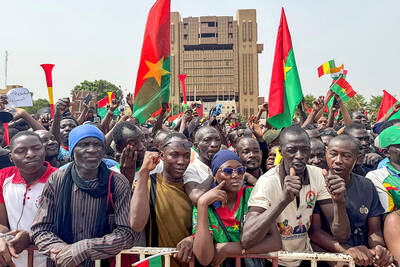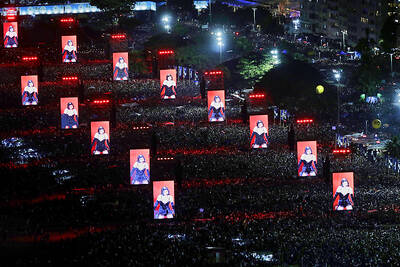A major earthquake hit a distant, sparsely populated region of Russia's Far East early yesterday, causing unknown damage and possible injuries, emergency officials said. The US Geologic Survey and Japan's Meteorological Agency estimated the temblor to be about 7.7 in magnitude.
The quake hit at around 12:30pm yesterday in the Koryak region, nearly 7,000km east of Moscow and some 1,000km north of the largest city in the area Petropavlovsk-Kamchatsky, said Oleg Kotosanov, a duty officer with the regional emergency situations ministry.
Kotosanov said by telephone that there were reports of damage in some villages of the Pacific region, and that emergency officials were flying by helicopter to several locations. Federal emergency officials in Moscow said they had no information about the quake.
Another duty officer at the Koryak regional emergency situations ministry said that there was no telephone communication with the affected region and that reconnaissance helicopters would reach the village of Tilichiki, apparently the hardest hit site, only at about 6pm. Some 2,028 people live in the coastal village, he said.
Emergency officials in Koryak said as far as they knew, some people had suffered only bruises. Russian news agencies said buildings including a school, two nursery schools, a hospital and a local airfield in Tilichiki had been damaged, along with municipal electric and heating systems. The agencies said some insignificant injuries had been reported.
Russia's north Pacific coast sits along a major tectonic plate and is frequently hit by earthquakes.
"It's the largest event in this area since 1900," US Geological Survey spokeswoman A.B. Wade said. "It's a sparsely populated area; up to 2,000 people were exposed to intensive shaking."
By comparison, the great San Francisco earthquake of 1906, which destroyed more than half of the city's buildings and left between 3,000 and 6,000 people dead, was estimated at a magnitude of between 7.7 and 7.9.

Kehinde Sanni spends his days smoothing out dents and repainting scratched bumpers in a modest autobody shop in Lagos. He has never left Nigeria, yet he speaks glowingly of Burkina Faso military leader Ibrahim Traore. “Nigeria needs someone like Ibrahim Traore of Burkina Faso. He is doing well for his country,” Sanni said. His admiration is shaped by a steady stream of viral videos, memes and social media posts — many misleading or outright false — portraying Traore as a fearless reformer who defied Western powers and reclaimed his country’s dignity. The Burkinabe strongman swept into power following a coup in September 2022

‘FRAGMENTING’: British politics have for a long time been dominated by the Labor Party and the Tories, but polls suggest that Reform now poses a significant challenge Hard-right upstarts Reform UK snatched a parliamentary seat from British Prime Minister Keir Starmer’s Labor Party yesterday in local elections that dealt a blow to the UK’s two establishment parties. Reform, led by anti-immigrant firebrand Nigel Farage, won the by-election in Runcorn and Helsby in northwest England by just six votes, as it picked up gains in other localities, including one mayoralty. The group’s strong showing continues momentum it built up at last year’s general election and appears to confirm a trend that the UK is entering an era of multi-party politics. “For the movement, for the party it’s a very, very big

ENTERTAINMENT: Rio officials have a history of organizing massive concerts on Copacabana Beach, with Madonna’s show drawing about 1.6 million fans last year Lady Gaga on Saturday night gave a free concert in front of 2 million fans who poured onto Copacabana Beach in Rio de Janeiro for the biggest show of her career. “Tonight, we’re making history... Thank you for making history with me,” Lady Gaga told a screaming crowd. The Mother Monster, as she is known, started the show at about 10:10pm local time with her 2011 song Bloody Mary. Cries of joy rose from the tightly packed fans who sang and danced shoulder-to-shoulder on the vast stretch of sand. Concert organizers said 2.1 million people attended the show. Lady Gaga

SUPPORT: The Australian prime minister promised to back Kyiv against Russia’s invasion, saying: ‘That’s my government’s position. It was yesterday. It still is’ Left-leaning Australian Prime Minister Anthony Albanese yesterday basked in his landslide election win, promising a “disciplined, orderly” government to confront cost-of-living pain and tariff turmoil. People clapped as the 62-year-old and his fiancee, Jodie Haydon, who visited his old inner Sydney haunt, Cafe Italia, surrounded by a crowd of jostling photographers and journalists. Albanese’s Labor Party is on course to win at least 83 seats in the 150-member parliament, partial results showed. Opposition leader Peter Dutton’s conservative Liberal-National coalition had just 38 seats, and other parties 12. Another 17 seats were still in doubt. “We will be a disciplined, orderly